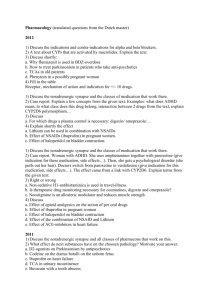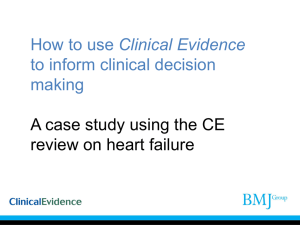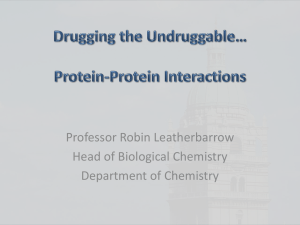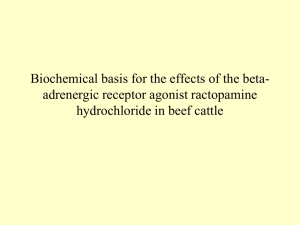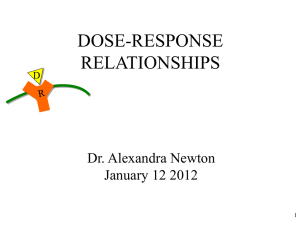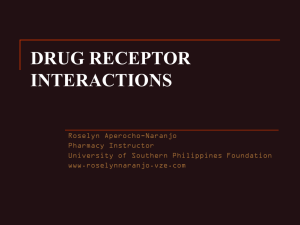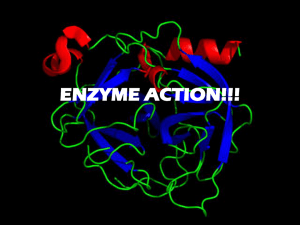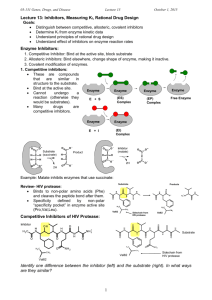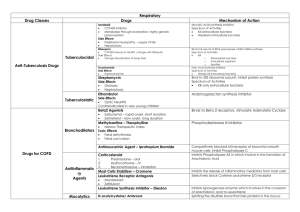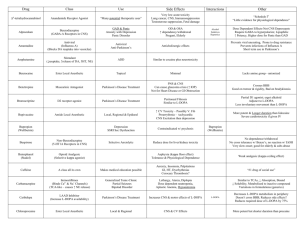Advanced Medicinal Chemistry
advertisement
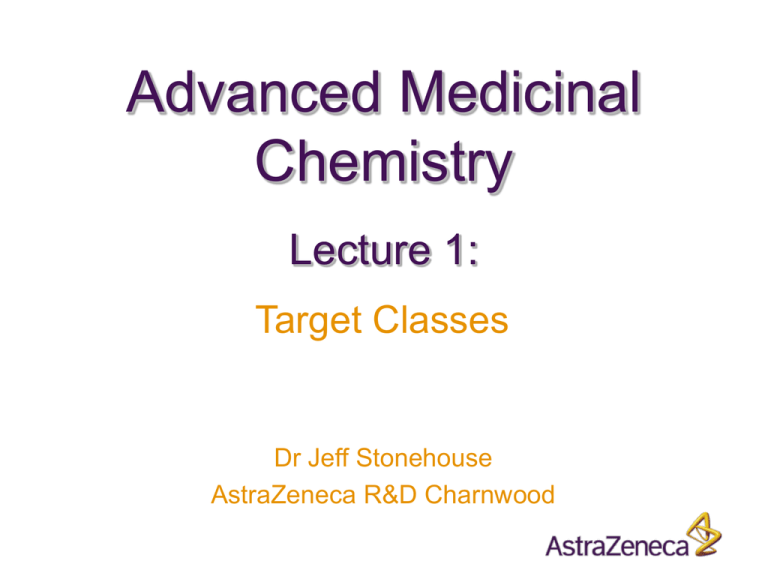
Advanced Medicinal Chemistry Lecture 1: Target Classes Dr Jeff Stonehouse AstraZeneca R&D Charnwood The Drug Discovery Process Target Identification 3 months to 2 years! HTS 3-4 months Active-to-Hit (AtH) 3 months Hit-to-Lead (HtL) 6-9 months New Lead Optimisation Projects (LO) 2 years Candidate Drug (CD) Taxonomy of Biological Mechanisms Receptors - In vivo Effectors agonists antagonists partial agonists inverse agonists Enzymes - inhibitors Ion Channels openers blockers Protein-Protein inhibitors Blockbuster Drugs Lipitor HMG CoA inhibitor HO Plavix Anti-platelet O OH Cl COOMe OH F N H N Enzyme Cholesterol Pfizer $12.0 billion Norvasc Calcium channel blocker Nexium Proton pump inhibitor Cl O O O N O O S N N Anti-ulcer AstraZeneca $4.8billion Receptor S Thrombosis BMS/Sanofi-Aventis $5.0billion O O N Enzyme N H O O Hyper-tension Pfizer $4.8billion NH2 Ion-channel Biological Mechanisms 2005 Top 50 drugs by Worldwide sales Enzyme Inhibitor 38% Receptor Antagonist 24% Misc 8% Receptor Agonist 12% Biological 10% Ion Channel Modulator 8% Enzyme function TS NH2 O Free Energy NH NH + H2N OH O NH2 O2 iNOS H2N OH O E S + NO Free Energy HN TS S P P Progress of Reaction E + S Progress of Reaction ES # E + P Active Site is tailored to bind the transition state for S P Usually, the substrate & inhibitors bind at the active site Allosteric (non-competitive) binding occurs remotely to the active site Enzyme Inhibition - Four mechanistic categories 1. Competitive inhibition. Inhibitor competes reversibly with substrate for the active site. 2. Uncompetitive inhibition. Inhibitor binds only to the ES complex, leading to EIS intermediates. This is very rare. 3. Non-competitive inhibition. Inhibitor binds non-covalently to sites other than the active site (Allosteric inhibition). Kinetics are complex and partially inhibited enzymes can still turn over substrate. Enzyme Inhibition - Four mechanistic categories 4. Irreversible inhibition. Inhibitor binds covalently, usually to the active site machinery. Also known as Suicide inhibitors. Examples include MAO inhibitors and b-lactamase inhibitors: NH2 p-OH-Ph NH2 H N O Amoxycillin b S N OH turnover O p-OH-Ph O HO H N S O HN CO2H O Clavulanic acid N O CO2H OH CO2H b Scys OH irreversible inhibition b O O Proteases (proteinases, peptidases) Hydrolytically cleave peptidic amide bonds Endopeptidases Exopeptidases cleavage site may be anywhere in the substrate terminal residue (carboxypeptidase, aminopeptidase) Four Mechanistic Classes Nucleophile pH preference Endo/Exo Serine Ser-CH2OH ~7 endo Cysteine (thiol) Cys-CH2SH ~7 endo Aspartic H 2O 3-6 endo Zinc (metallo) H 2O ~7 endo/exo Protease Specificity Determined by the binding of substrate amino acid side-chains near the cleavage site Specificity-Pocket nomenclature (Schechter & Berger, Biochem Biophys Res Com, 1967, 27, 157-162) substrate N-terminus N H S3 S1 S2’ P3 P1 P2' O H N N H O P2 S2 .. E-XH non-prime side H N O N H O H N Substrate C-terminus O P1' P3' S1’ S3’ prime side Serine Proteases Thrombin, Tryptase , b-Lactamase, Elastase, Chymotrypsin, HCV-NS3 Asp102 Catalytic triad O O boosts serine nucleophilicity H Inhibitors create or mimic stable tetrahedral intermediates N His57 N N enzyme H O O Ser 195 P1 substrate O H N N H b-lactams O NHCOR CF3 trifluoromethyl ketones P1' O P1 is the primary specificity site O N O S X O saccharins Biological Mechanisms 2005 Top 50 drugs by Worldwide sales Receptor Antagonist 24% Enzyme Inhibitor 38% Misc 8% Receptor Agonist 12% Biological 10% Ion Channel Modulator 8% Receptors Receptors are membrane-bound proteins that bind endogenous ligands (usually extracellular) to induce a phsiological effect (usually intracellular) A receptor is often the first step in a long intracellular signalling cascade leading to physiological effects G-Protein Coupled, Seven-Transmembrane Spanning Receptors comprise the majority of known examples extracellular 7TM GPCR intracellular a-adrenoceptor extracellular loops ligand recognition & binding N-terminus I membrane intracellular loops signalling G-protein coupling C-terminus Binding to Receptors R R* ground-state receptor Excited-state receptor no signal signal Agonist a ligand that binds to, and provokes a signal from a receptor via conformational changes in the excited state Antagonist a ligand that binds to a receptor and induces no signal. Blocks agonist binding. Little conformational change overall ligands can be proteins, peptides or small molecules Binding to Receptors Agonists & Antagonists bind competitively - beware misunderstandings from binding data without further functional analysis Endogenous agonists often bind weakly (enthalpy driven) Successful antagonists often bind tightly (entropy driven) Agonist Partial Agonist Antagonist Inverse Partial Agonist Inverse Agonist Biological Mechanisms 2005 Top 50 drugs by Worldwide sales Receptor Antagonist 24% Enzyme Inhibitor 38% Misc 8% Receptor Agonist 12% Biological 10% Ion Channel Modulator 8% Ion Channels All of life exists within an electric potential window of less than one volt The membrane potential of most cells is 60-70mV Ion channels regulate passive ion flow through membranes in an electric or concentration gradient Channels are ion selective and comprise groups of glycoprotein subunits in homo- or heteropolymer arrays. Almost no channels have an open rest state Channels are involved in cardiac, neuronal, psychiatric and (?) R&I disorders Which ions? hERG (iKr) channel: Na+ K+ Ca++ - ( Cl ) blockade causes prolongation of cardiac Q-T interval “Long QT syndrome” can lead to sudden death Ion Channels Channel families are complex, but all channels are either Voltage-gated or Ligand-gated Ligands can be other ions, small molecules or toxins & venoms such as tetrodotoxin, pumiliotoxin, margatoxin & charybdotoxin Blockbuster antihypertensive drugs have emerged from calciumchannel antagonist programmes – Nifedipine, Nimodipine, Isradipine, Amlodipine (NorVasc™)
